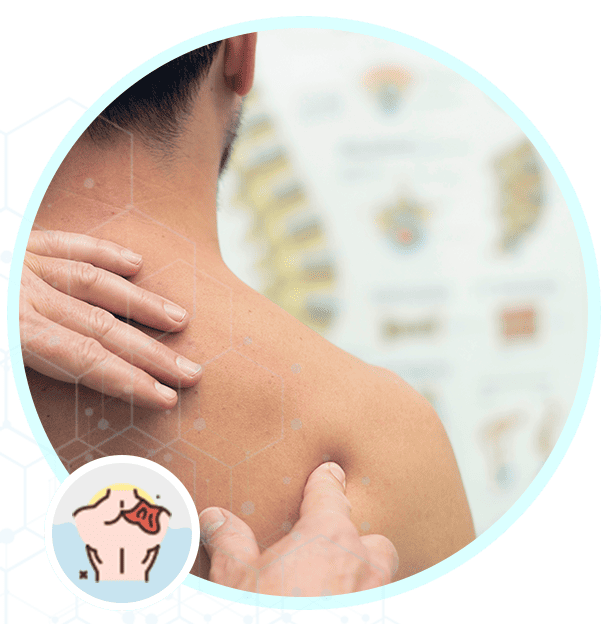
The shoulder joint is a highly mobile joint between the shoulder blade (also called ‘scapula’) and the arm (also called ‘humerus’). The shoulder joint connects the upper body to the arm. Its function is to allow positioning of the hand enabling it to perform various tasks. It is commonly affected by sports injuries and wear and tear. When affected, it causes pain, restricted movement or instability, which compromises the overall function of the upper limb.
Shoulder surgery is a medical procedure performed to treat injuries, degenerative diseases, or structural issues in the shoulder joint. When conservative treatments like physical therapy, medication, or injections fail, surgery is often the next step. It is usually performed through two approaches :
- Arthroscopic Surgery – During arthroscopic surgery, tiny incisions are made over the shoulder joint through which the camera and other instruments are inserted. These are used to perform repair of the torn tendons or ligaments such as rotator cuff repair or labral repair.
- Open Surgery – Open surgery is performed via long incision over the skin either on the front or side or back of the shoulder. These classically are used for surgical fixation of a fracture or a joint replacement surgery.
Preoperative Considerations
Diagnosis: MRI, CT, and X-rays help confirm the issue.
Non-surgical Options First: Most doctors try physical therapy, cortisone shots, or rest before suggesting surgery.
Prehab: Physical therapy before surgery may improve outcomes.
Informed Consent: Patients must understand risks, expected outcomes, and recovery.
Surgical Procedure
Setting: Usually same-day surgery unless a full replacement is done.
Anesthesia: General or regional (nerve block).
Duration: Typically 1–2 hours.
Postoperative Recovery
- Immediate Aftercare
* Use of a sling for several weeks.
* Pain managed with NSAIDs, opioids (short-term), or nerve blocks.
* Ice and elevation to reduce swelling.
- Rehabilitation
Phase 1 (0–6 weeks): Immobilization with passive movement.
Phase 2 (6–12 weeks): Active-assisted and active motion.
Phase 3 (3–6 months): Strengthening and return to full activity.
- Return to Work/Sport
Desk work: 2–4 weeks.
Manual labor: 4–6 months.
Sports: 4–9 months depending on sport and surgery type.
Benefits
* Pain relief.
* Improved shoulder function and strength.
* Greater range of motion.
* Return to normal activity or sport.
* Slows down degenerative changes in the joint.
Risks and Complications
* Infection.
* Stiffness.
* Nerve or blood vessel damage.
* Failure of repair or need for revision surgery.
* Complications from anesthesia.
* Blood clots (rare in upper extremity procedures).
Patient Experiences
Positive Experiences:
* Many patients report significant pain relief and improved function.
* Athletes often regain pre-injury performance levels.
* Arthroscopic procedures generally result in faster recovery and fewer complications.
Challenging Experiences:
* Long recovery time can be frustrating.
* Physical therapy is often intensive and critical to success.
* Sleep disturbances due to pain are common early on.
* Some elderly patients or those with massive rotator cuff tears may experience only partial improvement.
Shoulder surgery can be highly effective when done for the right reasons, with careful pre-op planning and diligent post-op rehab. While recovery can be lengthy and requires patience, the outcomes are generally favourable, particularly for patients motivated to follow through with therapy.
-
Rotator cuff Tear
-
Shoulder Instability or dislocation or labral tear
-
SLAP tear
-
Shoulder arthritis
-
Acromio-clavicular joint arthritis
-
Acromio-clavicular joint dislocation
-
Calcific tendinitis
-
Frozen shoulder
-
Biceps tendonitis or Proximal biceps rupture
-
Shoulder Impingement
-
Pectoralis major tendon tear
-
Collarbone (Clavicle) fracture
-
Upper arm bone (Humerus) fracture
-
Shoulder blade (Scapula or Glenoid) Fracture
-
Suprascapular nerve compressive neuropathy or entrapment
-
Sterno-clavicular joint instability
-
Sterno-clavicular joint arthritis
-
Snapping scapula syndrome
-
Scapula dyskinesis
-
Winged scapula
-
Shoulder arthroscopy
-
Arthroscopic rotator cuff repair
-
Superior capsular reconstruction
-
Tendon transfer
-
Biceps tendonitis or Proximal biceps rupture
-
Labral repair – Bankart/ Posterior labral repair
-
Arthroscopic latarjet
-
Arthroscopic bone block procedure (anterior/ posterior)
-
SLAP repair
-
Arthroscopic excision of calcific deposits
-
Arthroscopic capsular release
-
Arthroscopic ACJ repair/ reconstruction
-
Arthroscopic distal clavicle excision
-
Comprehensive arthroscopic management (CAM)
-
Hemiarthroplasty
-
Total anatomic shoulder replacement
-
Reverse shoulder replacement
-
Pectoralis major tendon repair
-
Open reduction internal fixation (ORIF) clavicle
-
Open reduction internal fixation (ORIF) humerus
-
Arthroscopic supraspinatus nerve decompression
-
Sterno-clavicular joint procedures (Excision or Reconstruction)
-
Scapulothoracic arthroscopy
-
Scapulothoracic fusion
-
Biologic resurfacing of glenoid
-
Glenohumeral fusion




